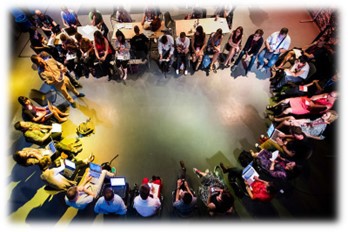Governance of the Power Platform via Community
The Microsoft Power Platform, an integrated set of tools and services for data visualization, app development, and workflow automation, is aptly named. Each of these uses intuitive no-code or low-code experiences and the platform precisely follows the Microsoft mission statement of “Empowering every person and every organization on the planet to do more.” Anyone and everyone can suddenly become a “maker” and can forge tremendous progress in digitally transforming their lives and work.
The solutions that get built can be natively integrated to other popular services, such as Microsoft Teams and GitHub. That’s truly powerful, but it begs some questions: When everyone is suddenly a maker, is there a tipping point where the massive influx of innovation overwhelms the individual or organization? Can the energy and interest behind the tools in the technology platform be guided so that chaos can be averted? Can that guidance also make positive and comprehensive transformation more likely while minimizing divergent efforts? If so, how?
Governance: The Dreaded “G-Word”
When any kind of powerful IT solution is introduced to organizations, the natural instincts of seasoned IT leaders and traditional IT pros may be to develop and deploy some sort of governance plan to address concerns around things like data security, application lifecycles, and more. The introduction of the Power Platform to an organization may stoke these instincts to a higher level because of how powerful the platform can be and how quickly and widely makers can impact the business. Having seen many examples of the disastrous impact of new, unplanned, or untested technology on businesses, those traditional IT leaders may not fully embrace the potential wave of newly minted “citizen developers” in their organization and, out of an abundance of caution, may stretch traditional governance schemes and approaches to address their concerns.
However, in this new paradigm of no-code/low-code solutions, that traditional approach can only get you part of the way there. With so much potential power in the hands of so many, makers will continue to make, and likely at a faster pace than the traditional IT governors can govern. The typical IT instinct to clamp down by shutting off access or licenses may be strong, but that will likely only force the makers to find other tools, or stifle innovation and the collaborative spirit among colleagues within the organization. People generally don’t like the feeling of being restricted, and some have developed an aversion to the mere mention of the word governance. It just sounds awful and people can feel that.
Taking the Dread Out of the “G-Word”
Governance is absolutely crucial, but a new way of thinking and talking about it may be required. Governance should be about setting the conditions that make it easier to do the right thing and harder to do the wrong thing beyond a simple list of “thou shalt nots.”
Governance is about guidance and guard rails – kinder and gentler “g-words” – to keep makers moving in a positive direction. Under the proper conditions, these guard rails can allow more freedom and productivity than an environment without governance because it keeps makers focused and guided, not constrained and oppressed, as some might fear.
A Sports Analogy
In bowling, there are clear instructions: Roll the ball down the lane and knock down the pins. When you first learn to bowl, there are inflatable bumpers down the lane that keep the ball in the lane, making your primary objective more achievable. These bumpers are a form of governance. They’re presented with context and clarity, and they’re clearly helpful. They’re not seen as oppressive. The bumpers help you to do the right thing, while also helping you to not do the wrong thing. When your skills improve, the bumpers are removed, but your confidence and ability to achieve the objective remain high. You still operate within the framework. You know the rules and you get results. That‘s effective governance.

Power to the People
A robust people-first program and attitude should be cultivated as part of any Power Platform governance model. Raising general awareness of the capabilities of the platform will get the attention of many new makers, drawing them into an exciting world of possibilities. The “Wow! It can do that – and I can make that?” moments will ignite new passions and new connections back to the work being done in an organization.
When everyone is a maker, everyone also has the responsibility and role of making sure that whatever is made works. That requires proper governance and guidance, and this is the central notion. Sure, people must acquire some familiarity and skills with the Power Platform to make solutions, but that’s the easy part. Establishing and managing a sensible work governance scheme is the crucial part.
Your organization may provide structured training efforts or even formal programs as part of the guidance model, where levels of achievement can be tracked and displayed. These makers of all skill levels, along with traditional IT people and business process owners, form the basis of your Power Platform community. The community itself provides the basis for your organization’s growth and adoption of the Power Platform. The makers, often the ones closest to the business challenges and the ones with the deepest subject-matter expertise, can take their new interest and skills in low-code/no-code development and attack issues head on, often with speed, agility, frequency, and general gusto.
That gusto (another “g-word” with some positive vibes) can be infectious and inspire others to learn and to try out their own solutions. A culture of sharing and of positive reinforcement can emerge, and those with more experience or achievement on the platform can act as mentors to the others. With that culture of clarity and sharing, innovation can thrive without fear of wasting development efforts on a solution that’s already been made. With guidance, those energies can be redirected toward sharpening existing solutions and broadening well-tested applications across the organization. The more successful no-code solutions, having proven the worthiness of their approach and effectiveness as a tool, can also graduate and more easily evolve into more robust “pro-code” solutions, if needed.
A Powerful Community
Building a successful Power Platform takes a community with a variety of skills and personalities. You’ll need:
- A network of makers, process owners, technical staff, and executive leaders
- To share ideas and solutions
- To jointly define issues, opportunities, and boundaries
- To celebrate successes
- To curate and advertise a catalog of applications and solutions made by the community
- To embark on continuous teaching and learning along with continuous communication to achieve continuous improvement as a company, as a community, and as individuals

Community Success
Your Power Platform maker community, like any group founded with a specific purpose and on the principles of sharing and openness, will work best when it’s active. If members are stagnant or unwilling to share, or if nobody is dedicated to managing and occasionally provoking thoughts and actions in the community, it will be of little use. If you build it, they may come initially. But if you don’t ensure that it’s active and supported, it will wither and fade to nothing.
This means assigning deadlines, pairing or grouping people together whose skills enhance one another’s, and keeping track of who’s doing what, what’s a priority, and what progress has been made. This means managing the community.
Community Management
Membership activity level increases if the community is managed well. Community managers can be anyone (or a mix of several people), but their efforts are focused on engaging with the community members, managing the content or products of the community, and communications with and integrations to the organization’s strategic priorities. The role of the community manager(s) can sound daunting, and although a mix of skills and disciplines are required, help and guidance is available. One of the best resources for this is an organization of community managers called the Community Roundtable. Through years of research and practice, they’ve developed comprehensive yet approachable frameworks of practices that organizations can use to build and manage communities. Community management is one of those “it takes a village” kind of activities and the Community Roundtable helps you define a village that suits your organization and needs.
Think Frameworks, Not Fences
The work of the Community Roundtable also highlights another key point about governance as we shift the definition from one of strict control to one of clear guidance. The less comfortable ideas of governance invoke feelings of being penned in, with no chance to make any slight variation. When framed as guidance and with clear expectations of what’s possible and how to best achieve things in practical and tangible ways, any necessary boundaries or fences are given more respect. Organizations can be clear that within the stated boundaries, work can actually be easier and more productive. Also, within those boundaries, there’s an active community to support you and your efforts. Outside those boundaries, work is more difficult and the chances of lasting success are lower.
Talking about governance as guidance and frameworks rather than strict limits and fences may even allow makers a sense of freedom to achieve the desired outcome. With this change in perception about governance, the makers who are being governed become more excited, willing, and engaged in a community that’s clearly open and productive. The maker practices also become more consistent and more well-known through repetition and documentation, making the job of building and maintaining the framework easier.


